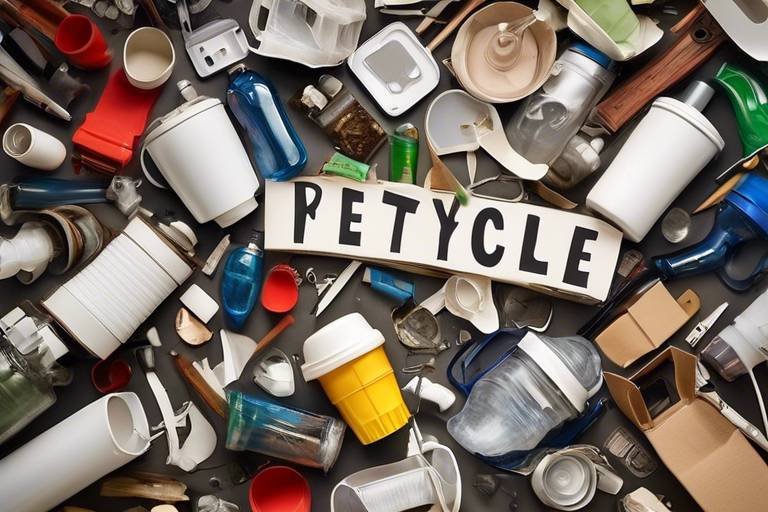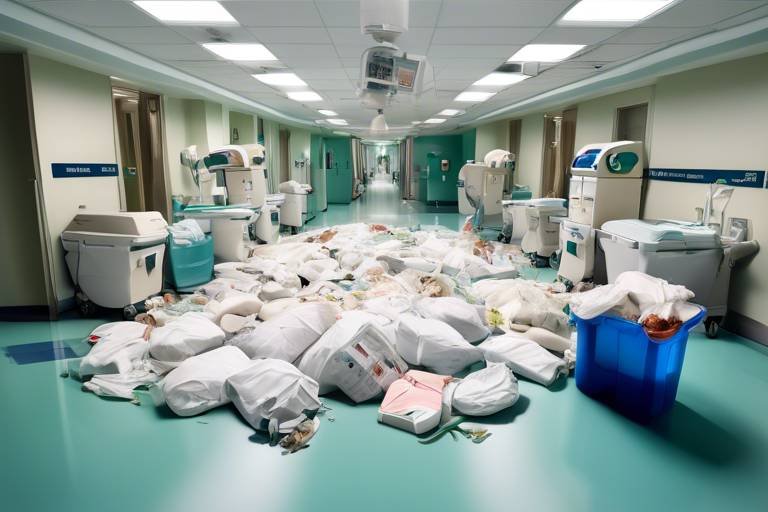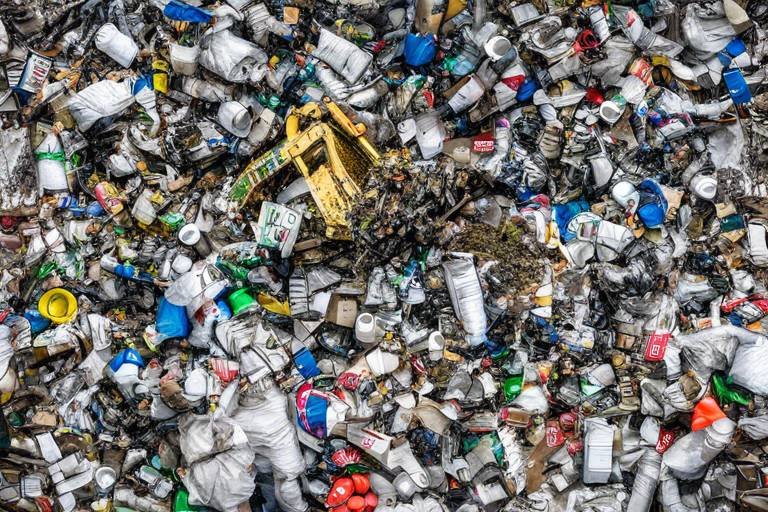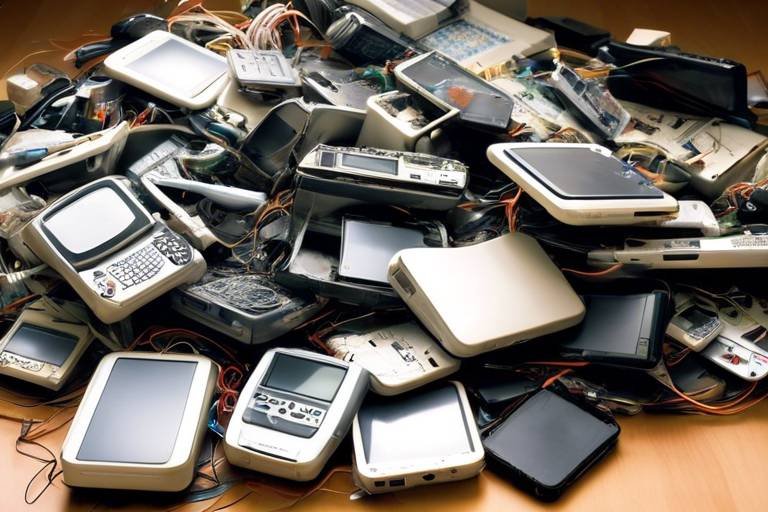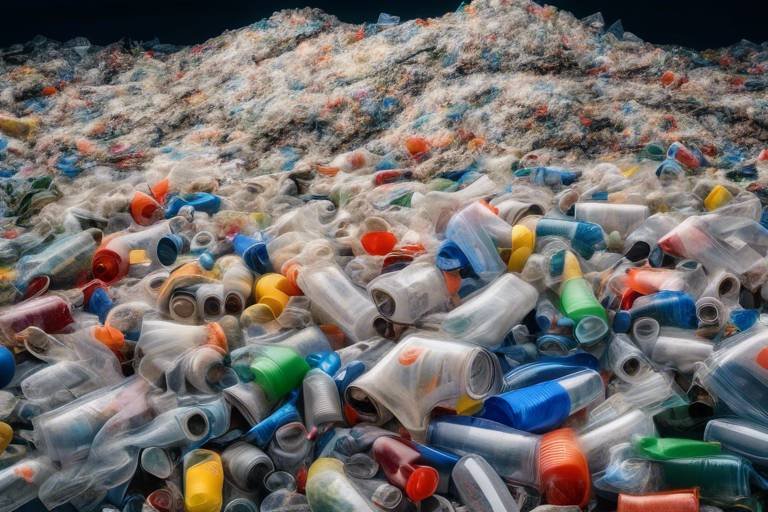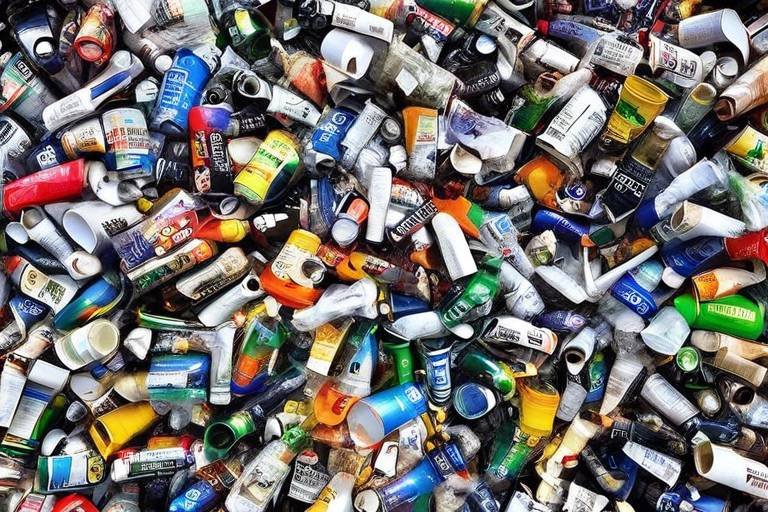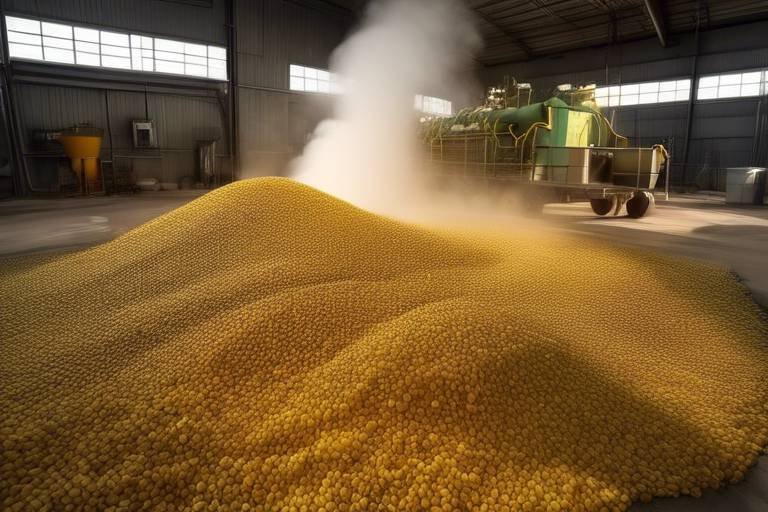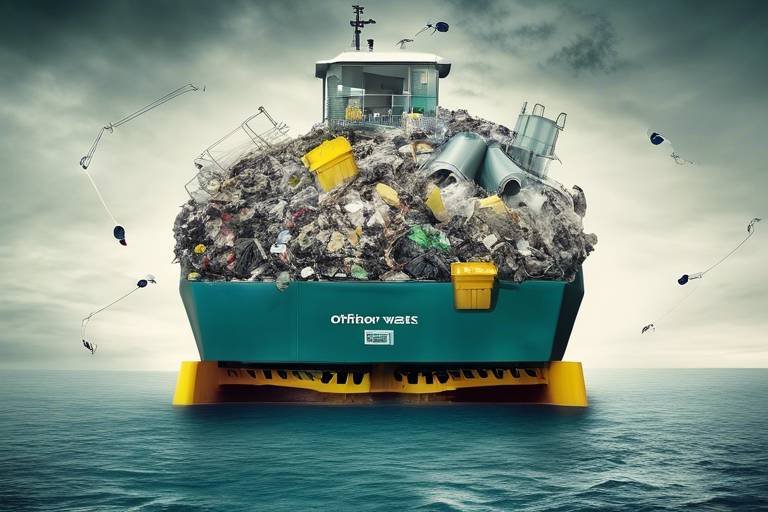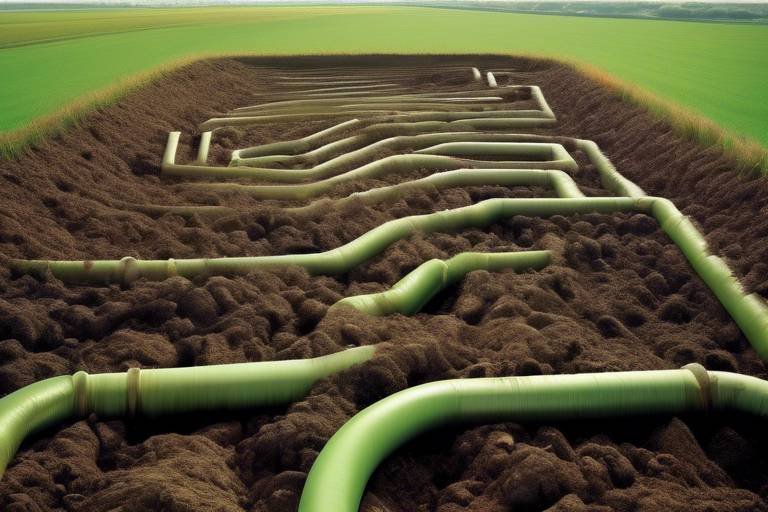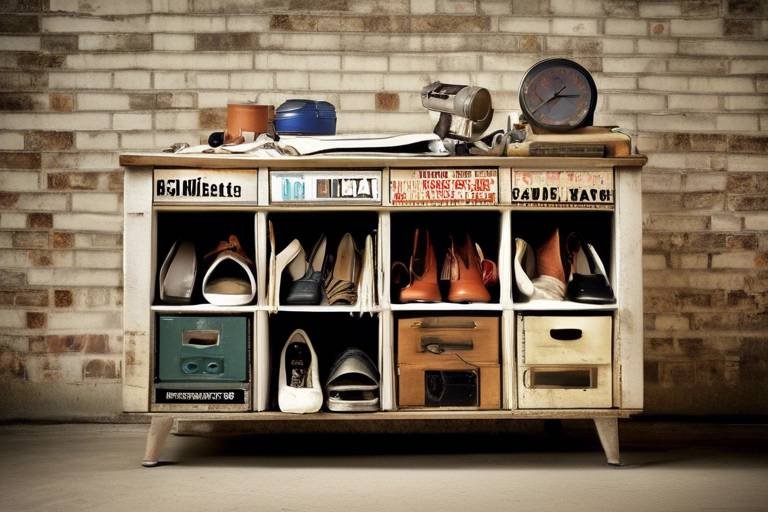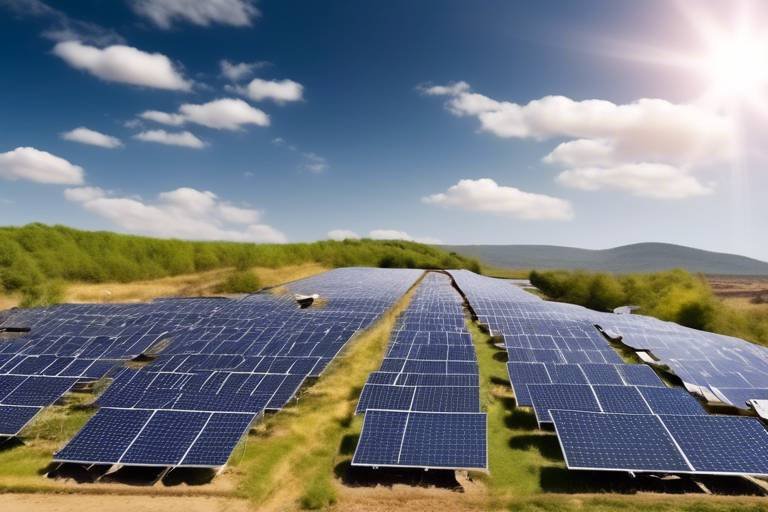How to Recycle Household Items?
Recycling household items is not just a trend; it's a crucial step towards creating a sustainable environment. With the growing concern for our planet, many of us are looking for effective ways to reduce waste and promote eco-friendly practices right from our homes. But where do you start? It can feel overwhelming at first, but fear not! This article will guide you through the ins and outs of recycling common household items. From understanding recycling symbols to knowing which items can be recycled and how to properly prepare them, we’ve got you covered. Imagine transforming your trash into treasure—each bottle, each box, and each gadget can find a new life instead of ending up in a landfill. Let's dive in and explore how you can make a difference!
Familiarizing yourself with recycling symbols can greatly enhance your recycling efforts. These symbols, often found on packaging, indicate whether an item is recyclable and how it should be disposed of. By understanding them, you can make informed decisions about what goes into your recycling bin. For example, the familiar triangle made of arrows signifies that the material can be recycled, but the number inside tells you what type of plastic it is. This knowledge is essential, as it helps you sort your waste correctly and ensures that recyclables don’t end up in the landfill. So, the next time you pick up a product, take a moment to check its recycling symbol—your planet will thank you!
Many everyday items can be recycled, but it’s essential to know which ones are commonly accepted. Items like plastic bottles, cardboard, and glass jars are often recyclable, but the rules can vary by location. To make your recycling efforts effective, consider the following common household items:
- Plastic Bottles: Always rinse them out before recycling.
- Cardboard: Flatten boxes to save space in your recycling bin.
- Glass Jars: Remove lids and rinse thoroughly.
By knowing what to recycle, you can significantly reduce the amount of waste your household produces. Remember, recycling is not just about throwing items into a bin; it’s about preparing them properly for their next journey!
Plastic containers are among the most widely recyclable items, but it’s crucial to clean and sort them correctly. Many people don’t realize that contamination can ruin an entire batch of recyclables. To recycle plastic containers effectively, follow these best practices:
Understanding the different types of plastics and their recycling codes is vital for proper sorting. Plastics are categorized by numbers ranging from 1 to 7, each representing a different type of resin. Here’s a quick breakdown:
| Plastic Type | Recycling Code | Notes |
|---|---|---|
| Polyethylene Terephthalate | 1 | Widely recycled; often used for bottles. |
| High-Density Polyethylene | 2 | Common for milk jugs and detergent bottles. |
| Polyvinyl Chloride | 3 | Less commonly recycled; used for pipes. |
| Low-Density Polyethylene | 4 | Used for grocery bags; check local guidelines. |
| Polypropylene | 5 | Often used for yogurt containers; recycling varies. |
| Polystyrene | 6 | Commonly found in foam products; less recyclable. |
| Other | 7 | Includes various other plastics; check local rules. |
Cleaning your plastic containers before recycling is crucial. A quick rinse can make a significant difference, as leftover food or liquids can contaminate the recycling stream. Here are some effective cleaning methods:
- Rinse with warm water and a small amount of dish soap.
- Use a scrub brush for stubborn residues.
- Let them air dry before placing them in the recycling bin.
By following these guidelines, you ensure that your recyclables are contamination-free, making it easier for recycling facilities to process them.
Paper and cardboard are among the easiest materials to recycle. They can be turned into new products, reducing the need for virgin materials. To prepare these items for recycling, flatten cardboard boxes and remove any plastic or metal components. The benefits of recycling paper and cardboard include conserving trees, saving energy, and reducing landfill waste. Plus, it’s an easy way to contribute to a greener planet!
Electronics, often overlooked, contain valuable materials that can be recycled. Proper disposal and recycling methods for electronic devices are essential to prevent environmental harm. Many electronics contain toxic substances that can leach into the environment if not disposed of correctly. It's vital to recycle these items responsibly!
Locating certified e-waste recyclers in your area is crucial for responsible disposal. Many communities have designated drop-off points or special collection events. Use online resources or local government websites to find reputable services that recycle electronics safely. Remember, recycling your old gadgets not only helps the environment but also recovers precious materials that can be reused!
Before recycling electronics, it’s necessary to prepare them properly. This includes:
- Data Wiping: Ensure all personal data is erased.
- Removing Batteries: Take out batteries, as they require special handling.
- Disassembling Components: If possible, separate parts for better recycling.
By taking these steps, you ensure that your electronics are recycled safely and responsibly.
Establishing a recycling routine at home can simplify the process and encourage family participation. Having a designated place for recyclables makes it easier to remember to recycle. Think of it as creating a habit—once it's part of your daily routine, it becomes second nature!
Setting up designated recycling bins throughout your home can streamline the recycling process. Consider labeling bins for different materials such as plastics, paper, and electronics. This organization enhances efficiency and makes recycling a breeze!
Engaging family members in recycling efforts fosters a sense of responsibility. Make it a fun activity by hosting a family recycling day or challenge each other to see who can collect the most recyclables. It’s a great way to bond while also teaching valuable lessons about sustainability.
Q: What items can I recycle at home?
A: Common items include plastic bottles, cardboard, paper, glass jars, and certain electronics. Always check local guidelines for specifics.
Q: Do I need to clean recyclables before placing them in the bin?
A: Yes, rinsing out containers helps prevent contamination and ensures that recyclables are processed properly.
Q: Where can I recycle electronics?
A: Look for certified e-waste recyclers in your area, often found through local government websites or recycling programs.
Q: How can I involve my kids in recycling?
A: Create fun challenges, set up a rewards system, or organize family recycling days to engage them actively!

Understanding Recycling Symbols
When it comes to recycling, understanding the recycling symbols is crucial for making informed decisions about what can and cannot be recycled. These symbols are not just random designs; they carry significant meaning and provide essential information about the materials used in products. Each symbol typically consists of a triangle made of arrows, which represents the recycling process. But wait, there's more! Inside that triangle, you might see a number or letters that indicate the type of material. Familiarizing yourself with these symbols can help you reduce waste and promote sustainability in your everyday life.
For instance, the number inside the triangle, often referred to as the recycling code, ranges from 1 to 7. Each number corresponds to a specific type of plastic, which dictates how it should be processed in recycling facilities. Here's a quick breakdown of what these numbers mean:
| Recycling Code | Type of Plastic | Common Uses |
|---|---|---|
| 1 | Polyethylene Terephthalate (PETE) | Soft drink bottles, food containers |
| 2 | High-Density Polyethylene (HDPE) | Milk jugs, detergent bottles |
| 3 | Polyvinyl Chloride (PVC) | Pipes, clear food packaging |
| 4 | Low-Density Polyethylene (LDPE) | Grocery bags, bread bags |
| 5 | Polypropylene (PP) | Yogurt containers, straws |
| 6 | Polystyrene (PS) | Disposable coffee cups, plastic food boxes |
| 7 | Other (Various) | Multi-layered plastics, some types of nylon |
By knowing which symbols to look for, you can easily identify recyclable materials in your home. However, it’s not just about recognizing these symbols; understanding the recycling process is equally important. Each material has its own recycling requirements and processes. For example, while most plastics can be recycled, they often need to be cleaned and sorted correctly to avoid contamination. This means that before tossing an item into the recycling bin, you should check for any leftover residues or mixed materials that could hinder the recycling process.
Moreover, some materials might not be accepted for curbside recycling at all! It’s essential to check with your local recycling program to understand what is accepted in your area. Remember, just because something has a recycling symbol doesn't mean it can be recycled in your community. This is where local guidelines come into play, ensuring that you’re doing your part to help the environment.
In conclusion, being aware of recycling symbols and understanding their implications can significantly enhance your recycling efforts. It’s not just about throwing things in a bin; it’s about being an informed consumer and making choices that lead to a more sustainable future. So next time you’re about to toss something away, take a moment to check the symbol and think about its potential for recycling!
- What do the recycling symbols mean? The recycling symbols indicate the type of material used in a product and whether it can be recycled.
- How can I find out what can be recycled in my area? Check with your local waste management authority for guidelines on accepted recyclable materials.
- Do I need to clean my recyclables? Yes, cleaning your recyclables helps prevent contamination, making them easier to process.

Common Household Items to Recycle
Recycling isn't just a trend; it's a lifestyle choice that can significantly impact our planet. You might be surprised to learn that many of the everyday items we use can be recycled, reducing waste and promoting sustainability. From your morning coffee to your evening snack, countless items are waiting for a second chance at life. The process of recycling these common household items not only conserves natural resources but also saves energy and reduces landfill waste. So, what are these items, and how can you recycle them effectively?
Let's start with plastic bottles. These ubiquitous containers are often used for beverages, cleaning supplies, and more. The good news is that most local recycling programs accept them! However, it's essential to ensure they are clean and free of any residue. A quick rinse can go a long way in making sure your bottle is ready for recycling. Did you know that recycling one plastic bottle can save enough energy to power a 60-watt light bulb for up to six hours? That's pretty impressive!
Next up, we have cardboard. This material is not just for pizza boxes; it includes everything from shipping boxes to cereal boxes. Cardboard is widely accepted in recycling programs, but it should be flattened to save space in recycling bins. If you have any plastic or Styrofoam liners, make sure to remove them, as they can contaminate the recycling process. A fun fact: recycling cardboard saves more than 9 million trees every year!
Then, there are glass jars and bottles. Glass is 100% recyclable and can be recycled endlessly without losing quality. It's important to rinse them out to avoid contamination. You might be surprised to learn that recycling glass can save enough energy to power a home for up to four hours for every ton of glass recycled. So, the next time you're done with that spaghetti sauce, think twice before tossing it in the trash!
Another item that often gets overlooked is aluminum cans. These are commonly found in soda and food packaging. Aluminum is also endlessly recyclable, and recycling just one can saves enough energy to run a TV for three hours! Similar to glass, make sure to rinse them out before recycling.
Lastly, don't forget about paper products. This includes newspapers, magazines, and office paper. Most recycling programs accept these materials, but they should be kept dry and clean. Wet or contaminated paper can ruin entire batches of recycling. Interestingly, recycling paper can save up to 17 trees per ton of recycled paper!
To summarize, here are some common household items you can recycle:
- Plastic bottles
- Cardboard boxes
- Glass jars and bottles
- Aluminum cans
- Paper products
By recycling these items, you're taking a proactive step toward a greener planet. It's not just about reducing waste; it's about making conscious choices that contribute to a sustainable future. So, the next time you finish a drink or unpack a delivery, think about how you can give those items a new lease on life!
Q: Can I recycle pizza boxes?
A: It depends on your local recycling program. If the box is clean and free from grease, you can recycle it; otherwise, it should go in the trash.
Q: What should I do with plastic containers that are not recyclable?
A: If they're not recyclable, consider reusing them for storage or crafts. If they can't be reused, dispose of them in the trash.
Q: How can I find out what items are recyclable in my area?
A: Check your local waste management website for guidelines on recycling in your community. They often provide detailed lists of what can and cannot be recycled.
Q: Is it necessary to remove labels from glass jars before recycling?
A: It's not necessary, but rinsing the jars and removing any large labels can help streamline the recycling process.

Plastic Containers
Plastic containers are a staple in most households, serving various purposes from food storage to organizing household items. However, many people remain unaware of the importance of recycling these containers. By recycling plastic, we can significantly reduce the amount of waste that ends up in landfills, which is crucial for our environment. Did you know that plastic can take hundreds of years to decompose? This is why understanding how to recycle plastic containers effectively is essential.
First and foremost, it’s important to recognize that not all plastic containers are created equal. Different types of plastics have varying recycling capabilities, and knowing which ones can be recycled is key. For instance, containers made from polyethylene terephthalate (PET) and high-density polyethylene (HDPE) are widely accepted in recycling programs. These materials often have the recycling symbols #1 and #2, respectively. To help you identify these types, here's a quick reference table:
| Plastic Type | Recycling Code | Common Uses |
|---|---|---|
| Polyethylene Terephthalate | #1 | Soda bottles, water bottles |
| High-Density Polyethylene | #2 | Milk jugs, detergent bottles |
| Polyvinyl Chloride | #3 | Pipes, vinyl siding |
| Low-Density Polyethylene | #4 | Bags, some food containers |
| Polypropylene | #5 | Yogurt containers, straws |
Before tossing your plastic containers into the recycling bin, it’s crucial to clean and sort them properly. Contamination is one of the leading causes of recyclable materials being sent to landfills instead of being processed. A quick rinse with water can often do the trick, but for greasy or sticky containers, a bit of soap might be necessary. Remember, if you wouldn’t want to eat off it, don’t expect recyclers to handle it!
Additionally, it’s best to remove any non-plastic components, such as labels or lids, as these can complicate the recycling process. Some recycling facilities accept lids, while others don’t, so it’s always a good idea to check your local guidelines. By taking these extra steps, you’re ensuring that your plastic containers have the best chance of being recycled and repurposed.
In summary, recycling plastic containers is a simple yet impactful way to contribute to sustainability efforts. By knowing which plastics are recyclable and how to prepare them, you can make a significant difference in reducing waste. So, next time you finish a container of yogurt or a bottle of soda, remember to think twice before tossing it in the trash. Your small actions can lead to big changes!
- What types of plastic containers can be recycled? Most plastic containers with recycling codes #1 (PET) and #2 (HDPE) are widely accepted. Check local recycling guidelines for specifics.
- Do I need to clean my plastic containers before recycling? Yes, cleaning is essential to remove food residue and contamination, which can hinder the recycling process.
- Can I recycle plastic lids? It depends on local recycling rules. Some facilities accept them, while others do not, so it's best to check.

Types of Plastics
Understanding the different is crucial for effective recycling. Plastics are categorized based on their chemical structure and properties, and each type has a specific recycling code, which is usually found on the bottom of containers. This code, ranging from 1 to 7, helps recyclers identify the material and determine the best recycling method. Here’s a quick overview of the most common types:
| Recycling Code | Type of Plastic | Common Uses | Recyclability |
|---|---|---|---|
| 1 | Polyethylene Terephthalate (PET) | Plastic bottles, food containers | Widely recycled |
| 2 | High-Density Polyethylene (HDPE) | Milk jugs, detergent bottles | Widely recycled |
| 3 | Polyvinyl Chloride (PVC) | Pipes, vinyl flooring | Rarely recycled |
| 4 | Low-Density Polyethylene (LDPE) | Grocery bags, bread bags | Not commonly recycled |
| 5 | Polypropylene (PP) | Yogurt containers, straws | Increasingly recycled |
| 6 | Polystyrene (PS) | Disposable coffee cups, plastic food boxes | Not commonly recycled |
| 7 | Other (various plastics) | Multi-layer containers, certain types of nylon | Varies greatly |
Each type of plastic has its own set of challenges when it comes to recycling. For instance, while PET and HDPE are widely accepted by most recycling programs, materials like PVC and polystyrene can be problematic due to the chemicals they release during processing. This is why it’s essential to check local recycling guidelines to know what can be recycled in your area.
Moreover, understanding these types can also help you make more informed choices when shopping. For example, opting for products made from easily recyclable plastics, such as PP, can contribute to a more sustainable lifestyle. Remember, every small action counts, and by choosing the right materials, you can significantly impact the recycling ecosystem.
So, the next time you reach for a plastic item, take a moment to check its recycling code. It’s a simple step that can lead to a much larger impact on our planet. By being aware of the types of plastics and their recyclability, you’re not just cleaning your home; you’re also playing a part in a global effort to reduce waste and promote sustainability.
- What does the recycling code mean? The recycling code indicates the type of plastic and helps recyclers sort materials for processing.
- Are all plastics recyclable? No, not all plastics are recyclable. It’s essential to check local guidelines for what can be accepted.
- How can I clean my plastics before recycling? Rinse them thoroughly to remove any food residue and let them dry before placing them in the recycling bin.

Cleaning Guidelines
This article explores effective methods for recycling common household items, offering practical tips and insights to reduce waste and promote sustainability in everyday life.
Familiarizing yourself with recycling symbols can help you identify recyclable materials and understand the recycling process, ensuring you make informed decisions about waste disposal.
Many everyday items, such as plastic bottles, cardboard, and glass jars, can be recycled. Learn which items are commonly accepted and how to prepare them for recycling.
Plastic containers are widely recyclable, but it's essential to clean and sort them properly. Discover the best practices for recycling plastic containers effectively.
Understanding the different types of plastics and their recycling codes helps in properly sorting and recycling these materials, maximizing their reuse potential.
Cleaning your plastic containers before recycling is crucial. Contaminated recyclables can lead to entire batches being discarded, which is a waste of resources. To ensure your plastic containers are ready for recycling, follow these simple yet effective cleaning guidelines:
First, rinse out any leftover food or liquid from the containers. This step is critical because even small amounts of residue can contaminate the recycling stream. Use warm, soapy water for a thorough clean. If you're dealing with stubborn stains or odors, consider soaking the containers for a few minutes to loosen any residue.
Next, pay attention to the labels. While many labels are recyclable, they can sometimes interfere with the recycling process if they contain non-recyclable materials. If possible, remove the labels from your containers. If they are difficult to peel off, a quick soak in warm water can help release them.
After cleaning, allow the containers to dry completely before placing them in your recycling bin. Moisture can cause issues at recycling facilities, so it’s best to ensure they are dry. By following these guidelines, you not only contribute to a cleaner recycling process but also help in promoting a sustainable environment.
Paper and cardboard are among the easiest materials to recycle. Explore how to prepare these items for recycling and the benefits of doing so.
Electronics contain valuable materials that can be recycled. Discover the importance of proper disposal and recycling methods for electronic devices to prevent environmental harm.
Locating certified e-waste recyclers in your area is vital for responsible disposal. Learn how to find reputable services that recycle electronics safely.
Before recycling electronics, it's necessary to prepare them properly. Understand the steps to take, including data wiping and removing batteries, to ensure safe recycling.
Establishing a recycling routine at home can simplify the process and encourage family participation. Discover tips for creating an effective recycling system that works for you.
Setting up designated recycling bins throughout your home can streamline the recycling process. Learn how to organize bins for different materials to enhance efficiency.
Engaging family members in recycling efforts fosters a sense of responsibility. Explore fun ways to involve everyone in your household in recycling activities.
Q: Why is it important to clean recycling items?
A: Cleaning recycling items helps prevent contamination, ensuring that the materials can be effectively processed and reused.
Q: Can I recycle containers with labels on them?
A: While many labels are recyclable, it's best to remove them if possible to avoid contamination in the recycling process.
Q: How can I find local recycling facilities?
A: You can search online for local recycling programs or check with your city's waste management department for guidance.
Q: Are there any items that cannot be recycled?
A: Yes, items like greasy pizza boxes, plastic bags, and certain types of glass are often not accepted in recycling programs.

Paper and Cardboard
When it comes to recycling, are among the most straightforward materials to process. Think about it: every time you open a package or read a newspaper, you're likely holding something that can be recycled! These materials are not only easy to recycle, but they also have a significant impact on reducing waste and conserving resources. By recycling paper and cardboard, we can save trees, reduce energy consumption, and minimize pollution. Isn't it amazing how a small action can lead to big changes?
Before tossing your paper and cardboard into the recycling bin, it's essential to prepare them correctly. This means ensuring that they are clean and dry. For instance, if you've got pizza boxes, make sure to remove any leftover grease or food particles, as contamination can spoil the entire batch of recyclables. Here are some simple steps to follow:
- Flatten all cardboard boxes: This not only saves space in your recycling bin but also makes it easier for recycling facilities to process them.
- Remove plastic windows: Many envelopes come with plastic windows; be sure to remove these before recycling.
- Keep paper dry: Wet paper can clump together and become unusable, so store it in a dry place until you’re ready to recycle.
Additionally, it's worth noting that not all paper products are created equal when it comes to recycling. For example, items like glossy magazines or paper coated with plastic may not be accepted in your local recycling program. Always check your local guidelines to understand what can and cannot be recycled. This way, you ensure that you're doing your part effectively!
Recycling paper and cardboard also has environmental benefits that extend beyond just reducing landfill waste. It significantly lowers energy usage compared to producing new paper products from raw materials. In fact, recycling one ton of paper can save up to 17 trees, 7,000 gallons of water, and 4,100 kilowatts of electricity. So, the next time you think about tossing that old box or crumpled paper, remember the impact your decision can have on our planet.
Incorporating paper and cardboard recycling into your daily routine can be as simple as setting up a designated bin in your home. You can even make it a fun family activity! Encourage your kids to help collect these materials, and you might find that they take pride in contributing to a sustainable lifestyle. Plus, it’s an excellent opportunity to teach them about the importance of recycling and caring for our environment.
To help you navigate the world of paper and cardboard recycling, here are some frequently asked questions:
| Question | Answer |
|---|---|
| Can I recycle colored paper? | Yes, colored paper is recyclable, but it's best to check with your local recycling program for specific guidelines. |
| What about shredded paper? | Shredded paper can be recycled, but it's often best to place it in a paper bag or box to prevent it from blowing away. |
| Are paper towels recyclable? | No, used paper towels are generally not recyclable due to contamination from food or cleaning products. |
By understanding how to recycle paper and cardboard properly, you're taking a significant step towards a more sustainable future. So, let's roll up our sleeves and start making a difference, one piece of paper at a time!

Electronics Recycling
In today's fast-paced world, we find ourselves surrounded by an array of electronic devices—from smartphones and laptops to televisions and kitchen gadgets. With technology evolving at lightning speed, these devices often become obsolete long before they wear out. This creates a pressing need for , not just to declutter our homes, but to protect our planet. Did you know that improper disposal of electronics can lead to hazardous materials leaching into the environment? That's right! Many electronic devices contain toxic substances that can harm wildlife and contaminate our soil and water. Therefore, understanding the importance of proper disposal and recycling methods for these items is crucial.
Recycling electronics is more than just a trend; it's a responsibility we all share. Many components found in electronic devices, such as metals, plastics, and glass, can be reclaimed and reused. This not only reduces the need for new raw materials but also minimizes energy consumption and greenhouse gas emissions associated with the manufacturing process. For instance, recycling one million laptops can save the energy equivalent to the electricity used by 3,657 homes in a year! Now, that’s a compelling reason to recycle!
When it comes to recycling electronics, the first step is to locate certified e-waste recyclers in your area. These organizations specialize in the safe and responsible recycling of electronic devices. It's essential to choose a reputable service to ensure that your old gadgets are handled correctly. Many local governments and community organizations offer e-waste collection events, making it easier than ever to recycle your old electronics. You can also check online platforms that connect consumers with certified recyclers. Remember, not all recycling centers accept every type of electronic waste, so it’s important to do your homework.
Before you take your electronics to a recycling center, preparation is key. This involves a few essential steps to ensure that the recycling process goes smoothly. First, you should wipe your data to protect your personal information. Most devices have built-in options to restore factory settings, which effectively removes your data. Additionally, it's important to remove batteries from devices, as they often require separate disposal methods. By following these steps, you not only contribute to a safer recycling process but also protect your privacy.
In summary, electronics recycling is a vital part of sustainable living. By understanding the importance of proper disposal and taking the necessary steps to prepare your devices, you can make a significant impact. So, the next time you upgrade your tech, remember to recycle your old devices responsibly. Together, we can create a cleaner, greener planet for future generations!
Q: What types of electronics can be recycled?
A: Most electronic devices can be recycled, including smartphones, computers, televisions, printers, and gaming consoles. However, it's best to check with your local recycling center for specific guidelines.
Q: Is there a cost associated with recycling electronics?
A: While many recycling programs are free, some may charge a small fee, especially for larger items like televisions. It's important to verify with your local recycler.
Q: Can I recycle my electronics if they are broken?
A: Yes! Broken electronics can often be recycled. Many recyclers can salvage parts or materials from non-working devices.
Q: How can I find a certified e-waste recycler near me?
A: You can search online for certified e-waste recyclers or check with your local government for recycling programs and events. Websites like Earth911.com can also help you locate nearby recycling options.

Finding E-Waste Recyclers
When it comes to recycling electronics, finding the right e-waste recyclers is crucial for ensuring that your devices are disposed of responsibly. With the rapid pace of technological advancement, many of us accumulate outdated electronics that we no longer use. These devices often contain harmful materials that can be detrimental to the environment if not disposed of properly. So, how do you find a reliable e-waste recycler? It’s simpler than you might think!
First and foremost, start by checking with your local government or waste management authority. Many municipalities have established programs for electronic waste recycling, which can help you locate certified recyclers in your area. You might be surprised to find out that some community centers or local retailers also host e-waste collection events, making it easier for you to drop off your old gadgets.
Another effective method is to utilize online resources. Websites like EPA's recycling locator can guide you to nearby e-waste recycling facilities. Additionally, many organizations, such as Call2Recycle, offer directories of certified recyclers specifically for batteries and electronics. By entering your zip code, you can quickly find a recycler near you.
It's also important to consider the credentials of the recycler. Look for certifications such as R2 (Responsible Recycling) or e-Stewards, which indicate that the recycler adheres to strict environmental and ethical standards. This ensures that your e-waste is handled safely and responsibly, reducing the risk of harmful materials ending up in landfills.
Furthermore, don’t hesitate to ask questions! A reputable recycler should be transparent about their processes. Inquire about how they handle data destruction, what happens to the materials after recycling, and whether they comply with local and federal regulations. This not only protects your personal information but also gives you peace of mind knowing that your electronics are being recycled properly.
To give you a clearer picture, here’s a simple table illustrating some common e-waste recyclers and their services:
| Recycler Name | Services Offered | Website |
|---|---|---|
| Best Buy | In-store recycling for various electronics | bestbuy.com |
| Staples | Electronics recycling and office equipment | staples.com |
| GreenDisk | Mail-in recycling for various e-waste | greendisk.com |
By following these steps, not only will you be able to find a reliable e-waste recycler, but you'll also be contributing to a more sustainable future. Remember, recycling electronics is not just about getting rid of old devices; it’s about making a conscious choice to protect our planet. So, gather up those old gadgets and take the first step towards responsible recycling!
Q: What types of electronics can be recycled?
A: Most electronics can be recycled, including computers, smartphones, tablets, TVs, and printers. Always check with your local recycler for specific guidelines.
Q: Is there a fee for recycling electronics?
A: Some recyclers may charge a fee for certain items, especially larger appliances. However, many locations offer free recycling for smaller electronics.
Q: What should I do with my personal data before recycling?
A: It's essential to wipe your devices clean of personal data before recycling. Use factory reset options or data-wiping software to ensure your information is removed securely.

Preparing Electronics for Recycling
When it comes to recycling electronics, preparation is key. You can't just toss your old gadgets into the recycling bin and expect them to be processed properly. Instead, there are essential steps you should follow to ensure that your electronic devices are ready for their second life. First and foremost, data security is a significant concern. Before you recycle your devices, you need to make sure that all your personal information is wiped clean. This means performing a factory reset on smartphones, tablets, and laptops. Don't forget to remove any external storage, such as SD cards or USB drives, as these can also contain sensitive data.
Another crucial aspect is battery removal. Many electronic devices contain batteries that can be hazardous if not disposed of correctly. For example, lithium-ion batteries found in smartphones and laptops can pose fire risks if they are damaged or improperly processed. Therefore, it’s wise to remove these batteries and take them to a designated battery recycling location. If you’re unsure about where to take them, many local retailers and recycling centers accept batteries for safe disposal.
Additionally, you should check if your electronics have any special recycling requirements. Some devices, like televisions and monitors, contain materials that need to be handled with care. This is where researching local recycling guidelines can be beneficial. Many municipalities offer specific programs for e-waste, so be sure to familiarize yourself with these options. You can often find this information on your local government's website or by calling your waste management department.
After ensuring that your devices are data-free and batteries are removed, consider cleaning your electronics. Dust and grime can accumulate over time, and while it may seem trivial, a clean device is much more appealing for recycling centers. Use a soft cloth and a mild cleaning solution to wipe down the surfaces. Just remember to avoid getting any liquid inside the device itself! Once everything is prepped, you can either drop off your items at a recycling center or look for special e-waste collection events in your area.
In summary, preparing your electronics for recycling involves several important steps:
- Wipe all personal data by performing a factory reset.
- Remove batteries and dispose of them at designated locations.
- Research local recycling requirements for specific devices.
- Clean your electronics before recycling.
By following these guidelines, you not only ensure that your electronics are recycled responsibly but also contribute to a healthier planet. Remember, every little bit counts when it comes to sustainability!
Q: What should I do with my old electronics?
A: You should prepare them for recycling by wiping personal data, removing batteries, and cleaning them before taking them to a recycling center.
Q: Can I recycle all types of electronics?
A: Most electronics can be recycled, but some items may have specific disposal requirements. Always check local guidelines.
Q: Where can I find e-waste recycling centers?
A: You can locate certified e-waste recyclers through your local government’s website or by searching online for e-waste recycling programs in your area.
Q: Is it safe to recycle electronics?
A: Yes, recycling electronics is safe when done through certified recycling programs. They follow strict guidelines to handle materials responsibly.

Creating a Recycling Routine
Establishing a recycling routine at home is a fantastic way to simplify the process of recycling and encourage everyone in your family to participate. Just like brushing your teeth or making your bed, recycling can become a habit that benefits not only your household but also the planet. Have you ever thought about how much waste we generate daily? By creating a structured routine, you can significantly reduce your household waste and contribute to a more sustainable future.
To kick things off, consider setting up designated recycling bins in various locations throughout your home. This can be as simple as having a bin in the kitchen for plastic containers, one in the office for paper, and another in the garage for electronics. By making it easy to sort items as you go, you’ll find that recycling becomes second nature. You might want to label each bin clearly, so everyone knows what goes where.
Moreover, it can be helpful to involve your family in the process. Turn recycling into a fun activity! For instance, you could have a family meeting to discuss the importance of recycling and brainstorm ideas on how to improve your routine. You might even consider setting up a friendly competition to see who can collect the most recyclable materials in a week. This not only makes the process engaging but also fosters a sense of responsibility among family members.
Additionally, consider creating a recycling calendar to remind everyone of recycling days and any special events, like neighborhood clean-ups or recycling drives. This way, everyone stays informed and engaged in the recycling process. You could also include educational tidbits about the benefits of recycling on the calendar, such as how much energy or resources can be saved by recycling certain materials.
In summary, by establishing a recycling routine, you are taking a proactive step towards reducing waste and promoting sustainability. Remember, it’s all about making it easy and fun for everyone involved. So, why not start today? Your future self—and the planet—will thank you for it!
- What items can I recycle at home? Most common items include plastic bottles, cardboard, paper, glass jars, and certain electronics.
- How can I ensure my recyclables are clean? Rinse out containers and remove any food residue before placing them in the recycling bin.
- Where can I find local recycling centers? Check your city’s waste management website for a list of local recycling facilities and their accepted materials.
- Is there a limit to how much I can recycle? Generally, there is no limit, but check with your local recycling center for any specific guidelines.

Designated Recycling Bins
Creating a system of in your home is one of the most effective ways to streamline your recycling efforts. Imagine walking into your kitchen and seeing clearly labeled bins for different materials—it not only makes recycling easier but also encourages everyone in the household to participate. By having specific bins for items like plastic, paper, glass, and electronics, you reduce the chances of contamination and ensure that recyclables are sorted correctly.
When you set up these bins, think about their placement. You want them to be easily accessible, so consider putting them in high-traffic areas such as the kitchen, garage, or even your home office. For instance, placing a bin under the sink for plastic containers and another next to your desk for paper waste can make a world of difference. This way, you can quickly toss items into the right bin without having to walk to a distant recycling station every time.
To help your family understand what goes where, using clear labels is crucial. You can create fun and colorful signs that not only specify what items belong in each bin but also include images for those who may not read yet. This visual aid can make recycling a family affair, turning it into an engaging activity for kids and adults alike.
Additionally, consider the size of your bins. Larger bins might be necessary for items that accumulate quickly, like cardboard and paper, while smaller bins can suffice for plastics and metals. You can even repurpose old containers or buckets, giving them a new life while saving money. Just remember, the easier you make it for your family, the more likely they are to embrace recycling as a regular habit.
Involving the family in the setup process can also be a fun bonding activity. Perhaps you can have a mini DIY project where everyone can decorate their designated recycling bins. This not only personalizes the bins but also instills a sense of ownership and responsibility towards recycling. As you work together, remind everyone of the importance of recycling and how their efforts contribute to a healthier planet.
Lastly, don't forget to establish a routine for emptying these bins. Make it a weekly family event to take the recyclables to your local recycling center or curbside pickup. By incorporating recycling into your routine, it becomes a natural part of your household activities, much like taking out the trash or doing laundry. Remember, every little bit counts, and your efforts can lead to a more sustainable future.
- What types of materials can I recycle at home? Most household items like plastic bottles, cardboard, paper, and glass jars are recyclable. Always check local guidelines for specifics.
- How can I ensure my recyclables are clean? Rinse out containers and remove any food residues before placing them in the recycling bin.
- What should I do with electronics that I want to recycle? Locate certified e-waste recyclers in your area and ensure you wipe any personal data from devices before recycling.
- Can I recycle items that are not accepted in my curbside program? Yes, many items can be taken to specialized recycling centers. Check local resources for options.

Involving the Family
Getting the whole family on board with recycling can be a game-changer! It’s not just about tossing items into the right bin; it’s about creating a culture of sustainability at home. Imagine if every family member understood the importance of recycling and actively participated in it. You could transform your household into a mini-eco-warrior team, fighting against waste and promoting a healthier planet!
Start by making recycling a fun and engaging activity. You could set up a family competition to see who can collect the most recyclables in a week. Not only does this encourage participation, but it also fosters a sense of responsibility among family members. You might be surprised at how creatively kids can think about recycling when they feel it’s a challenge. Consider creating a scoreboard in your kitchen to track everyone’s progress. This visual representation can spark excitement and motivate everyone to contribute.
Another great way to involve the family is through educational activities. Organize a family night where you watch documentaries about recycling or the impact of waste on the environment. Discuss what you learned afterward. You could even take it a step further and create a family recycling project, like turning old clothes into rags or making art from scrap materials. This hands-on approach not only teaches valuable lessons but also strengthens family bonds.
Don’t forget to assign specific roles based on age and ability. For instance, younger kids can help with sorting items, while older children can take charge of cleaning and preparing recyclables. This division of tasks makes the process smoother and gives everyone a sense of ownership. Plus, it’s a fantastic way to instill valuable life skills in your children.
Lastly, celebrate your recycling successes together! Whether it’s a small milestone like reducing waste by a certain percentage or completing a recycling project, take the time to acknowledge these achievements. You could have a special family dinner or a fun outing as a reward. This not only reinforces positive behavior but also shows that every effort counts in the grand scheme of environmental conservation.
Involving the family in recycling doesn’t have to be a chore; it can be an enjoyable and rewarding experience that brings everyone closer together. So, gather your loved ones, roll up your sleeves, and start making a difference—one recyclable at a time!
- Why is recycling important? Recycling helps reduce waste, conserves natural resources, and decreases pollution, making it essential for environmental sustainability.
- What items can I recycle at home? Common recyclable items include plastic bottles, cardboard boxes, glass jars, and certain electronics.
- How can I teach my kids about recycling? Use fun activities, educational games, and family projects to engage them in the recycling process.
- What should I do with electronics that can't be recycled? Look for e-waste recycling programs in your area that can safely dispose of or repurpose electronic waste.
Frequently Asked Questions
- What items can I recycle at home?
You can recycle a variety of household items including plastic bottles, cardboard, glass jars, and paper products. Just make sure to check your local recycling guidelines, as accepted materials can vary by location.
- How should I prepare plastic containers for recycling?
Before recycling plastic containers, it's essential to clean them thoroughly to remove any food residue. Rinse them out with water and let them dry. Also, make sure to check the recycling code on the bottom to ensure it's recyclable in your area.
- What are the different types of plastics?
Plastics are categorized by recycling codes, ranging from 1 (PETE) to 7 (other). Each type has different properties and recycling processes. Familiarizing yourself with these codes can help you sort your recyclables correctly.
- How do I find e-waste recyclers in my area?
To find certified e-waste recyclers, you can search online for local recycling centers or visit websites like Earth911 or Call2Recycle. These platforms help you locate nearby services that responsibly recycle electronic devices.
- What steps should I take before recycling electronics?
Before you recycle electronics, make sure to wipe any personal data from devices, remove batteries, and check if any parts can be reused or donated. This ensures safe recycling and protects your personal information.
- How can I create an effective recycling routine at home?
Start by setting up designated recycling bins in convenient locations around your home. Label each bin for different materials like plastics, paper, and metals. Involve your family by making recycling a fun activity, such as a game to see who can collect the most recyclables!
- Why is it important to involve my family in recycling?
Involving your family in recycling fosters a sense of responsibility and teamwork. It can be a fun way to educate children about sustainability and the impact of waste on the environment, making them more conscious of their habits.

